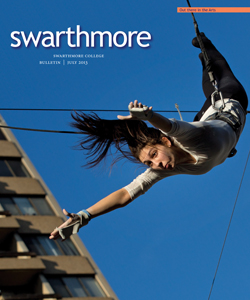Coming Home to Herself
Rachel Neumann ’92, Not Quite Nirvana: A Skeptic’s Journey to Mindfulness, Parallax Press, 2012, 
208 pp.
Spending time with this disarmingly moving book by Rachel Neumann ’92 is like sitting across a table with a close friend, sharing a meal—“friends, warm food, light elemental”—or simply a cup of nettle tea, “breathing and riding waves of joy and sadness as they fall.” Neumann evokes the virtues of “Interbeing,” using the vocabulary of Vietnamese monk and Buddhist activist Thich Nhat Hanh, when she speaks about patiently cultivating connections with others—being “available,” “engaged,” “connected”—and of creating intentional forms of community with our erstwhile neighbors—“the easy ones and the hard ones.”
Neumann also reflects throughout her book on experiences of commensality— community defined as the sharing of food, hospitality, the sometimes risky opening up of one’s home as a gathering place, “a community center and a think tank,” with an extra room and perhaps bed for the night. This sense of a shared community in which doors are open to all neighbors seems to come naturally to Neumann, who grew up in the ’60s as a commune kid.
Neumann is not only the child of a “hippie anarchist commune” and the personal editor for Thich Nhat Hanh and several other Buddhist teachers but a person for whom core Buddhist virtues of mindfulness, compassion, and the truths of impermanence and karma are always close at heart. She is also the child of her father, Osha, a “rebellious and angry child of German Jewish refugees—intellectuals whose only religion was rationality. …” Osha’s stepfather was Herbert Marcuse, whom Neumann visited in San Diego as a child, and whose critique of “repressive tolerance” she quotes in some detail, reflecting on her father’s influences. It is this blend of Nhat Hanh’s “engaged” Buddhist ideals and a critical, skeptical political consciousness that gives Neumann’s memoir its vital tensions and center of gravity. Do not judge others, for sure, but do not simply tolerate them either. Mindfulness and social critique exist in tension together.
The book begins in fall 2002, when Neumann begins working for Nhat Hanh, and weaves fluidly back and forth through her life, from her childhood as one of a roving gang of “dirty, half-naked children” on the commune, through the births of her two children (most notably Plum), her partnership with the father of her children, irreparable loss (“an idea named Grace”), and the quotidian struggles of motherhood and middle age.
After I finished the book, I closed my eyes, took a couple of deep breaths, and let one of the last images sink in: a family—a father, a mother, two young daughters—“burrowing into the darkness” of a grandmother’s house at Muir Beach, wrapped in blankets and listening “to the wind and the waves” as they talked about “the Earth tilting away from the sun here in the Northern Hemisphere.”
With subtle deep feeling, Neumann describes a gloriously present moment during the winter solstice when, as Nhat Hanh phrases it, one has “come home” to oneself. As Neumann herself remarks before describing this final scene of momentary familial peace, teetering in the darkness: “Even when I get home, I often forget to come home.” And “coming home to myself,” she then observes, “does not mean that I am alone.” As with many passages in this memoir, when Neumann “comes home” to herself, taking account of so many poignant and worrisome moments of her life as a child, a mother, an activist, and a life partner, she also invites the reader to come home with her.
This gracious book inspires us to periodically close our eyes, drawing in our energies to better witness the moment that is passing, but it also wills us to open them again and—with a bit of luck in this “unfair” world that is “not quite nirvana”—to emerge refreshed and newly engaged.
—Professor of Religion Steven Hopkins teaches the history, religion, and culture of India, with an emphasis on Hindu, Buddhist, Jain, and Islamic traditions and on Buddhist traditions of Asia, among other courses.
BOOKS
Peter Andreas ’87, Smuggler Nation: How Illicit Trade Made America, Oxford University Press, 2013, 454 pp. Andreas provides a historic perspective of smuggling goods into the United States, delivering a sweeping narrative history of contraband capitalism from colonial to modern times.
454 pp. Andreas provides a historic perspective of smuggling goods into the United States, delivering a sweeping narrative history of contraband capitalism from colonial to modern times.
Travis Beck ’96, Principles of Ecological Landscape Design, Island Press, 2013, 280 pp. Beck, a landscape architect, translates the science of ecology into landscape-design practice, explaining key ecological concepts and their application to the design and management of sustainable landscapes.
Courtney Bender ’91, Wendy Cadge ’97, Peggy Levitt, and David Smilde, Religion on the Edge: De-Centering and Re-Centering the Sociology of Religion, Oxford University Press, 2013, 297 pp. Thirteen essays challenge conventional scholarly approaches to the sociology of religion.
Daisy Fried ’89, Women’s Poetry: Poems and Advice, University of Pittsburgh Press, 2013, 75 pp. Critics have described Fried’s collection of poems as “vernacular,” “vigorous,” and “gimlet-eyed.” Fried offers a reimagination of women’s poetry that leaves readers both uneasy and revitalized.
 Wendy Cadge ’97, Paging God: Religion in the Halls of Medicine, The University of Chicago Press, 2012, 293 pp. Using the interviews and observations of nurses, doctors, and chaplains nationwide, the author explores the role of religion in the daily lives of doctors and other hospital staff.
Wendy Cadge ’97, Paging God: Religion in the Halls of Medicine, The University of Chicago Press, 2012, 293 pp. Using the interviews and observations of nurses, doctors, and chaplains nationwide, the author explores the role of religion in the daily lives of doctors and other hospital staff.
Thérèse Wilson and J. Woodland Hastings ’47, Bioluminescence: Living Lights, Lights for Living, Harvard University Press, 2013, 185 pp. The authors investigate a variety of luminescent organisms with the hypothesis that luciferase systems arose in the earliest life forms because of their ability to remove oxygen. These enduring light-emitting species avoided extinction by evolving uses for the light that aided survival—such as defense from predators, hunting, and courtship.
Robert Keighton ’53, Along the Brandywine, Artopia Press, 2012, 20 pp. The artist’s impressionist-style landscapes are created on location and from photographs. He is drawn to the Brandywine Valley because of its history and the beauty of the region.
Ingrid Kraus ’67, The Red Leather Chair, Wry Hill, 2012, 260 pp. In this story of betrayal in the American heartland, Kraus puts readers in the mind of each member of the Strayhorn family as they struggle with self-identification, revenge, and redemption.
Tom Owen-Towle ’63, Wake Up! Daily Lessons for a More Liberated and Loving Life, Aperion Books, 2013, 286 pp. Owen-Towle’s collection of life lessons and advice encourages readers to rejuvenate their spirituality and achieve a deeper state of consciousness and awareness.
2013, 286 pp. Owen-Towle’s collection of life lessons and advice encourages readers to rejuvenate their spirituality and achieve a deeper state of consciousness and awareness.
Edward Miller ’91, Misalliance: Ngo Dinh Diem, the United States, and the Fate of South Vietnam, Harvard University Press, 2013, 419 pp. According to the author, Ngo Dinh Diem, the controversial leader of South Vietnam assassinated in 1963, may not have been a pawn of the United States nor a stubborn traditionalist—as he is often portrayed—but rather a shrewd and ruthless leader with his own vision for the future of Vietnam.
Tonen O’Connor ’54, Buddhas Behind Bars, CreateSpace Independent Publishing Platform, 2012, 158 pp. O’Connor, a Soto Zen Buddhist priest, provides the introduction and afterthoughts and serves as editor for this collection of three prison inmates’ stories of violent crime and their later turn to Buddhist ideas and enlightenment.

Richard Valelly ’75, American Politics: A Very Short Introduction, Oxford University Press, 2013, 152 pp. Introducing all facets of the American political system, Valelly offers an objective primer on the history, evolution, and functioning of elements of U.S. democracy.
V.A. Musin, N.M. Kropachev, and Jane Picker ’57 (editor), Russian Law in Brief: Digest for Foreign Investors, St. Petersburg University Press, 2012, 680 pp. A comprehensive guide to Russian business law and its application, this book includes prefaces by Russian Prime Minister Dmitry Medvedev and ex-South Korean President Lee Myung-bak.
 Email This Page
Email This Page